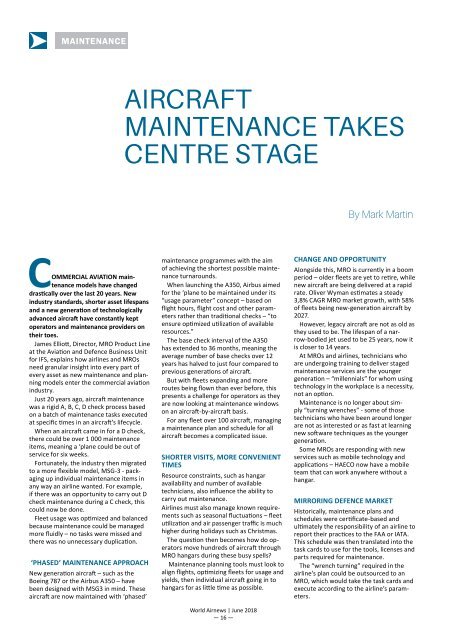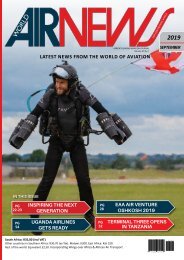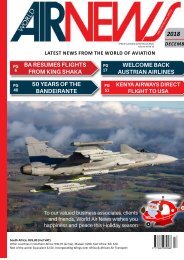World AirNews June 2018
- No tags were found...
You also want an ePaper? Increase the reach of your titles
YUMPU automatically turns print PDFs into web optimized ePapers that Google loves.
MAINTENANCE<br />
MAINTENANCE<br />
AIRCRAFT<br />
MAINTENANCE TAKES<br />
CENTRE STAGE<br />
By Mark Martin<br />
C<br />
OMMERCIAL AVIATION maintenance<br />
models have changed<br />
drastically over the last 20 years. New<br />
industry standards, shorter asset lifespans<br />
and a new generation of technologically<br />
advanced aircraft have constantly kept<br />
operators and maintenance providers on<br />
their toes.<br />
James Elliott, Director, MRO Product Line<br />
at the Aviation and Defence Business Unit<br />
for IFS, explains how airlines and MROs<br />
need granular insight into every part of<br />
every asset as new maintenance and planning<br />
models enter the commercial aviation<br />
industry.<br />
Just 20 years ago, aircraft maintenance<br />
was a rigid A, B, C, D check process based<br />
on a batch of maintenance tasks executed<br />
at specific times in an aircraft’s lifecycle.<br />
When an aircraft came in for a D check,<br />
there could be over 1 000 maintenance<br />
items, meaning a ‘plane could be out of<br />
service for six weeks.<br />
Fortunately, the industry then migrated<br />
to a more flexible model, MSG-3 - packaging<br />
up individual maintenance items in<br />
any way an airline wanted. For example,<br />
if there was an opportunity to carry out D<br />
check maintenance during a C check, this<br />
could now be done.<br />
Fleet usage was optimized and balanced<br />
because maintenance could be managed<br />
more fluidly – no tasks were missed and<br />
there was no unnecessary duplication.<br />
‘PHASED’ MAINTENANCE APPROACH<br />
New generation aircraft – such as the<br />
Boeing 787 or the Airbus A350 – have<br />
been designed with MSG3 in mind. These<br />
aircraft are now maintained with ‘phased’<br />
maintenance programmes with the aim<br />
of achieving the shortest possible maintenance<br />
turnarounds.<br />
When launching the A350, Airbus aimed<br />
for the ‘plane to be maintained under its<br />
“usage parameter” concept – based on<br />
flight hours, flight cost and other parameters<br />
rather than traditional checks – “to<br />
ensure optimized utilization of available<br />
resources.”<br />
The base check interval of the A350<br />
has extended to 36 months, meaning the<br />
average number of base checks over 12<br />
years has halved to just four compared to<br />
previous generations of aircraft.<br />
But with fleets expanding and more<br />
routes being flown than ever before, this<br />
presents a challenge for operators as they<br />
are now looking at maintenance windows<br />
on an aircraft-by-aircraft basis.<br />
For any fleet over 100 aircraft, managing<br />
a maintenance plan and schedule for all<br />
aircraft becomes a complicated issue.<br />
SHORTER VISITS, MORE CONVENIENT<br />
TIMES<br />
Resource constraints, such as hangar<br />
availability and number of available<br />
technicians, also influence the ability to<br />
carry out maintenance.<br />
Airlines must also manage known requirements<br />
such as seasonal fluctuations – fleet<br />
utilization and air passenger traffic is much<br />
higher during holidays such as Christmas.<br />
The question then becomes how do operators<br />
move hundreds of aircraft through<br />
MRO hangars during these busy spells?<br />
Maintenance planning tools must look to<br />
align flights, optimizing fleets for usage and<br />
yields, then individual aircraft going in to<br />
hangars for as little time as possible.<br />
CHANGE AND OPPORTUNITY<br />
Alongside this, MRO is currently in a boom<br />
period – older fleets are yet to retire, while<br />
new aircraft are being delivered at a rapid<br />
rate. Oliver Wyman estimates a steady<br />
3,8% CAGR MRO market growth, with 58%<br />
of fleets being new-generation aircraft by<br />
2027.<br />
However, legacy aircraft are not as old as<br />
they used to be. The lifespan of a narrow-bodied<br />
jet used to be 25 years, now it<br />
is closer to 14 years.<br />
At MROs and airlines, technicians who<br />
are undergoing training to deliver staged<br />
maintenance services are the younger<br />
generation – “millennials” for whom using<br />
technology in the workplace is a necessity,<br />
not an option.<br />
Maintenance is no longer about simply<br />
“turning wrenches” - some of those<br />
technicians who have been around longer<br />
are not as interested or as fast at learning<br />
new software techniques as the younger<br />
generation.<br />
Some MROs are responding with new<br />
services such as mobile technology and<br />
applications – HAECO now have a mobile<br />
team that can work anywhere without a<br />
hangar.<br />
MIRRORING DEFENCE MARKET<br />
Historically, maintenance plans and<br />
schedules were certificate-based and<br />
ultimately the responsibility of an airline to<br />
report their practices to the FAA or IATA.<br />
This schedule was then translated into the<br />
task cards to use for the tools, licenses and<br />
parts required for maintenance.<br />
The “wrench turning” required in the<br />
airline’s plan could be outsourced to an<br />
MRO, which would take the task cards and<br />
execute according to the airline’s parameters.<br />
Now, OEMs and MROs are transitioning<br />
towards new business models to take the<br />
whole maintenance aspect away from<br />
the airline. In a highly competitive arena,<br />
airlines want to concentrate on flying passengers,<br />
selling tickets, managing fuel costs<br />
and beating competition from international<br />
and low-cost airlines.<br />
Commercial aviation is following the<br />
defence model of in-service support ¬ --<br />
contracting out maintenance to OEMs or<br />
third-party providers. Outsourcing of line<br />
maintenance was one of the top three 2017<br />
MRO trends outlined by Technavio, while<br />
Boeing and Airbus have set up their own<br />
MRO divisions where they are looking to<br />
generate $50-billion in annual revenue.<br />
But OEM contracts are taking a while to<br />
be introduced as airlines are reluctant to be<br />
locked into an expensive in-service support<br />
contract. Independent MROs are realizing<br />
they occupy a competitive position to<br />
provide fleet planning and the “wrench<br />
turning” associated with meeting that new<br />
model.<br />
NEW APPROACH REQUIRED<br />
Regardless of the chosen model, the end<br />
goal is to reduce aircraft maintenance<br />
windows – the number one competitive<br />
differentiator between maintenance<br />
providers. From a planning perspective,<br />
what used to be called “out of phase maintenance”<br />
in the days of ABCD is now the<br />
industry standard -- whole maintenance<br />
programmes are planned with individual<br />
tasks in mind.<br />
This requires MRO software which<br />
recognizes and packages individual tasks<br />
where they fit best according to scheduling<br />
parameters – flight hours, flight cycles etc.<br />
Software with a component-based view<br />
offers significant advantages by getting<br />
part numbers and granular detail into each<br />
maintenance programme. That information<br />
should then be packaged into the required<br />
maintenance format – task by task, component<br />
by component.<br />
This means as maintenance models and<br />
standards continue to shift, the software<br />
can easily adapt to keep track of all components.<br />
ADAPT TO SURVIVE<br />
As commercial aviation MRO continues<br />
to move forward, those who adapt fast<br />
will remain competitive in a consolidating<br />
market.<br />
But these opportunities cannot be realized<br />
without component-centric support,<br />
providing the granularity required to react<br />
and take advantage of new maintenance<br />
models. Q<br />
<strong>World</strong> Airnews | <strong>June</strong> <strong>2018</strong><br />
— 16 —<br />
<strong>World</strong> Airnews | <strong>June</strong> <strong>2018</strong><br />
— 17 —





